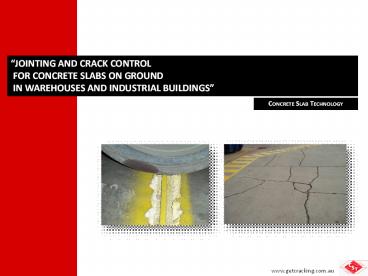Concrete Slab Technology - PowerPoint PPT Presentation
1 / 28
Title:
Concrete Slab Technology
Description:
JOINTING AND CRACK CONTROL FOR CONCRETE SLABS ON GROUND IN WAREHOUSES AND INDUSTRIAL BUILDINGS CONCRETE SLAB TECHNOLOGY www.getcracking.com.au www.getcracking ... – PowerPoint PPT presentation
Number of Views:562
Avg rating:3.0/5.0
Title: Concrete Slab Technology
1
Jointing and Crack Control for Concrete Slabs
on Ground in warehouses and industrial
buildings
Concrete Slab Technology
2
CONCRETE SLABS ON GROUND
- Cracks
- Concrete shrinkage restraint
- Use of steel reinforcement for crack width
control how effective is it? - JOINTS
- New problems for joints caused by use of-
- Laser screeds
- Hard-wheeled forklifts
- ALTERNATIVE SOLUTION - CRACK CONTROL
- - JOINT OPENING CONTROL
- Mechanical cracking of sawcut joints
3
CONCRETE SHRINKAGE RESTRAINT
- All concrete shrinks as it cures (even with
admixtures) - To avoid cracking, must avoid restraining
concrete shrinkage - Restrained Shrinkage Minimising Restraint
4
SOURCES OF RESTRAINT
Slab Tied to Walls
Slab Penetrations
Subgrade Friction
Set-downs
5
DETAILING FOR STRESS RELIEF
6
SUBGRADE RESTRAINT
- Stress due to subgrade restraint depends on
- Subgrade material
- Length of pour
7
SUBGRADE RESTRAINT
- Stress is maximum in the centre of the slab
- Crack usually occurs in centre of slab first
8
SUBGRADE FRICTION AND CRACK DEVELOPMENT
Sawcuts
48m
9
CONCRETE SLABS ON GROUND
- Cracks
- Concrete shrinkage restraint
- Use of steel reinforcement for crack width
control how effective is it? - JOINTS
- New problems for joints caused by -
- Laser screeds
- Hard-wheeled forklifts
- ALETERNATIVE SOLUTION FOR CRACK CONTROL
- Mechanical cracking of sawcut joints
10
USE OF STEEL MESH
- Steel mesh in concrete slabs on ground-
- Does not prevent cracks
- Does not increase load carrying capacity
- Steel is used to control crack width
11
USE OF STEEL MESH
- Continuously Reinforced Concrete Pavements
- 0.6 - 0.7 steel
- Tight cracks at close centres
- Works fairly well
- Expensive
12
USE OF STEEL MESH
- Industrial Building slabs on ground
- Much less steel - 0.1 - 0.15 steel
- Poor crack width control for large pours
- Sawcut joints open wide at mesh discontinuities
- Poor control of sawcut joint widths
13
USE OF STEEL MESH
DESIGN CONSIDERATION
- Steel quantity required depends on-
- Length of pavement with continuous reinforcement
- Subgrade friction
- Magnitude of thermal shrinkage
- Magnitude of drying shrinkage
- Required crack width
- Required crack spacing
- Use of stress concentrators (e.g. sawcuts)
- Pavement thickness
- Concretes tensile strength
- Diameter of steel reinforcement
- Yield stress of steel reinforcement
STEEL MESH DESIGN IS COMPLICATED!
14
PROBLEMS CAUSED BY STEEL MESH
- Restricts cracks opening
- Limits cracks ability to accommodate shrinkage
- Creates more cracks
- Concrete pump required for accurate mesh
positioning - Increased fines in concrete mix design
- Leads to increased concrete shrinkage
- Leads to increased joint widths
- Increased cost of construction
15
PROBLEMS CAUSED BY STEEL MESH
- Creates residual tensile stress in the slab
- Adds to other stresses from
- Applied loads
- Shrinkage stresses
- to increase risk of cracking
16
PROBLEMS CAUSED BY STEEL MESH
- Can create plastic settlement cracks
- Grid of cracks mirroring bars in mesh below
17
PROBLEMS CAUSED BY STEEL MESH
- Difficult to place and compact concrete
- Poor compaction reduces concrete strength
18
PROBLEMS CAUSED BY STEEL MESH
- Steel manufacture creates greenhouse gas
emissions - Mass of CO2 emissions from steel manufacture and
distribution is approx. twice the weight of steel - e.g. 1500m2 of SL92 mesh 12 tonnes of CO2
19
CONCRETE SLABS ON GROUND
- Cracks
- Concrete shrinkage restraint
- Use of steel reinforcement for crack width
control how effective is it? - Use of steel mesh in slabs on ground to control
cracking is far from ideal - JOINTS
- New problems for joints caused by -
- Hard-wheeled forklifts
- Laser screeds
- ALETERNATIVE SOLUTION FOR CRACK CONTROL
- Mechanical cracking of sawcut joints
20
PROBLEMS CAUSED BY HARD-WHEELED FORKLIFTS
- Hard-wheeled forklifts
- Are here to stay (improved forklift stability)
- Cause damage to unprotected joint edges
- Joint armouring of construction joints
- Difficult to accurately install
- Expensive
21
PROBLEMS CAUSED BY LASER SCREEDS
- Increasing use of laser screeds
- Economies with large pours up to 3000m2 per day.
- Large pours lead to
- Wide openings at construction joints
- Dominant sawcut joints at centre of pour
Easily damaged by hard wheeled forklifts
11mm wide sawcut, 3 months after concrete
placement
22
CONCRETE SLABS ON GROUND
- Cracks
- Concrete shrinkage restraint
- Use of steel reinforcement for crack width
control how effective is it? - JOINTS
- New problems for joints caused by -
- Laser screeds
- Hard-wheeled forklifts
- ALETERNATIVE SOLUTION FOR CRACK CONTROL
- Mechanical cracking of sawcut joints
23
CONVENTIONAL METHOD - SAWCUT JOINTS CRACKING OVER
TIME
NEW METHOD -MECHANICALLY CRACKED JOINTS
- Sawcut joints cracked early.
- Tensile stress never accumulates.
- Stresses insufficient to cause unplanned cracks
24
MECHANICALLY INDUCING A CRACK
25
(No Transcript)
26
JOINT CRACKING MACHINE
27
MECHANICAL CRACKING OF SAWCUT JOINTS
- Use of steel mesh in slabs on ground to control
cracking is far from ideal - By mechanically cracking sawcut joints, soon
after concrete placement - Random shrinkage cracks eliminated
- Joints open more evenly
- With shrinkage cracks controlled to sawcut joints
the following can be eliminated - Steel reinforcing mesh and its associated
problems - Concrete Pumps
- With joints opening relatively evenly
- Semi-rigid sealants can be used to protect joints
- No need for joint-edge armouring
- Without steel reinforcing mesh
- Greenhouse gas emissions are greatly reduced
28
CONCLUSION
- For more information visit www.getcracking.com.au

